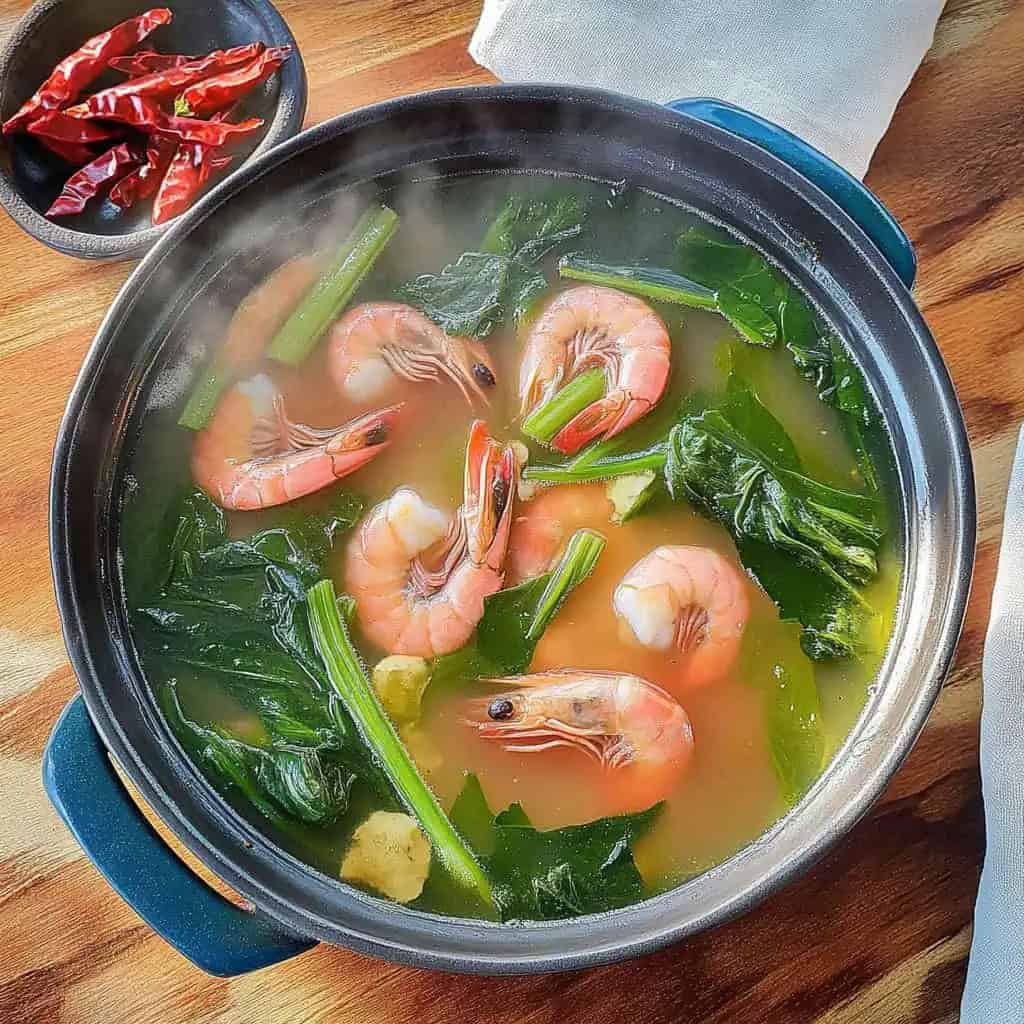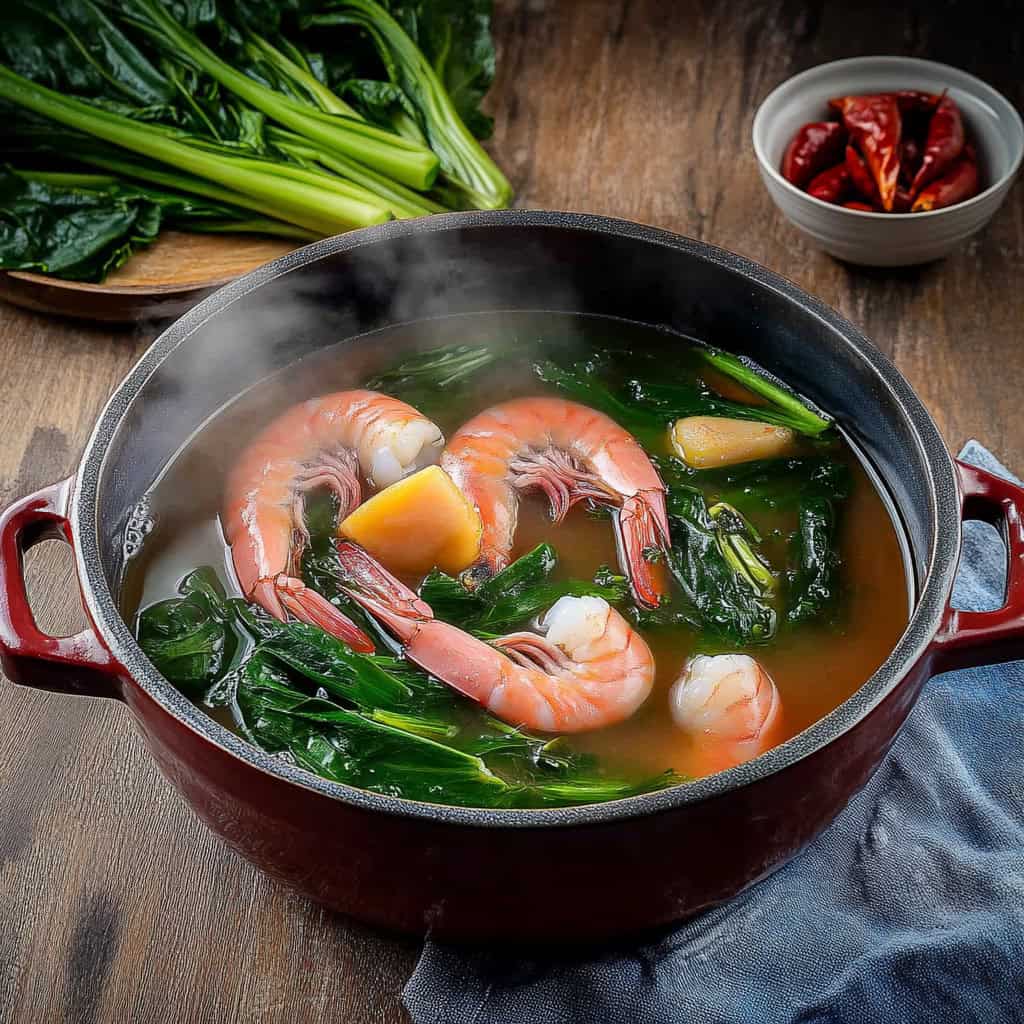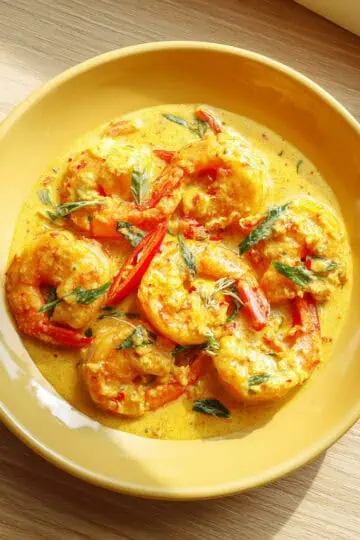Whenever I visit my titas in Pampanga, there's one dish that they never fail to cook for me - Bulanglang na Hipon. My cousins and I would gather around the kitchen, breathing in the sweet-sour aroma of guavas simmering with fresh shrimp, while our titas share stories of how their own mothers taught them this recipe.
What makes this Kapampangan version of sinigang special is how it uses guavas instead of the usual sampaloc, creating this amazing light broth that's both refreshing and comforting. It's one of those recipes that really shows off Pampanga's reputation as the culinary capital of the Philippines.
Jump to:

Why You'll Love This Recipe
- Perfect balance of sour and sweet flavors from fresh guavas
- Light yet satisfying soup that's ideal for any weather
- Ready in under 45 minutes
- Packed with protein and nutrients
- Authentic Kapampangan recipe passed down through generations
- Budget-friendly and uses easily accessible ingredients
- Customizable spice and sourness levels
Ingredients
The ingredients in Bulanglang na Hipon work together to create a perfectly balanced dish. Guavas provide a gentle sweet-sour flavor that's milder than tamarind, complementing the natural sweetness of fresh shrimp rather than overpowering it.
Head-on shrimp add richness to the broth as their flavorful fats melt during cooking. Kangkong (water spinach) offers a crisp texture and earthy flavor that balances the delicate broth, while also absorbing the soup's essence. White onion creates an aromatic foundation, and the optional chilies allow for customizable heat.
Together, these simple ingredients create a light yet satisfying soup that highlights Pampanga's talent for transforming local, accessible ingredients into sophisticated dishes with complex flavors.

- 1 pound head-on large shrimp
- 7 large ripe guavas (mixed ripeness preferred)
- 5 cups water
- 1 large white onion, peeled and quartered
- Salt to taste
- 1 bunch water spinach (kangkong)
- Optional: 2-3 finger chilies (siling pangsigang)
Equipment
- Large pot or Dutch oven (kaldero): For cooking the soup and providing enough space for all ingredients to simmer properly.
- Fine-mesh strainer (salaan): Essential for extracting the guava juice without pulp or seeds.
- Sharp knife (kutsilyo): For precise cutting of ingredients.
- Wooden spoon (sandok): Allows for gentle stirring without damaging delicate ingredients.
- Measuring cups and spoons (Panukat): Ensures accurate measurements for consistent results.
- Small bowl: Used for the guava juice extraction process.
- Cutting board (Tabla): Provides a stable surface for safe ingredient preparation.

How To Make
- Take your shrimp, cut off the tendrils but keep the heads on. Wash them well and set aside.
- Cut all your guavas in half. Using a spoon, scoop out the seeds and pulp into a bowl. Add 1 cup of water to the seeds and pulp, then mash everything together with the back of your spoon. Strain this through a fine-mesh strainer to get the guava juice. Keep this juice for later.
- For your kangkong (water spinach), cut off 2 inches from the bottom of the stalks and throw these away. Cut the rest into 3-inch pieces, keeping the stalks separate from the leaves. Wash well and drain.
- Get a large pot and set it over medium heat. Pour in 4 cups of water, add your quartered onion, and the halved guavas. Let it come to a boil. Once boiling, lower the heat, cover the pot, and let it simmer until the guavas become soft - about 10-12 minutes.
- Pour in the guava juice you saved earlier. Add your shrimp and cook for 4-5 minutes until they turn pink. Add salt to taste.
- Add the kangkong stalks first, then after 30 seconds, add the leaves. Cook just until the leaves wilt but stay bright green - about 30 seconds more.
- Serve hot with rice and fish sauce on the side. For extra heat, you can add sliced chilies to your soup or fish sauce.
Remember: You'll know your shrimp is perfectly cooked when they're pink and curled into a loose 'C' shape. If they curl into a tight 'O', they're overcooked.

Tips from Lola's Kitchen
- Use rice washing water: Replace plain water with rice washing water (hugas bigas) for a deeper flavor and slight thickness that enhances the broth.
- Balance your guavas: Use a mix of ripe and green guavas for the perfect sweet-sour balance. Riper guavas add sweetness while greener ones provide more tartness.
- Perfect timing for kangkong: Add kangkong at the very end of cooking and in stages (stems first, then leaves) to maintain their crispness and vibrant color.
- The power of shrimp heads: Never discard the shrimp heads as they contain flavorful fats that create a richer, more aromatic broth when they melt into the soup.
- Control your heat level: Add chilies whole during cooking, then remove before serving for a mild heat, or slice them to release more spice.
- Taste as you go: The sourness of guavas can vary greatly, so taste your broth before adding salt and adjust accordingly.
Substitutions
- Guavas: If fresh guavas aren't available, use guava powder, tamarind paste, or kamias (bilimbi) as alternative souring agents.
- Kangkong: Substitute with pechay (bok choy), spinach, or gabi (taro) leaves for different textures and flavors.
- Head-on shrimp: Peeled shrimp can work but reduce cooking time to prevent overcooking. Whole fish or pork can be used for different variations.
- White onion: Red onion or shallots offer a slightly different aromatic profile.
- Fresh chilies: Dried chilies, chili flakes, or chili oil can be used for heat if fresh aren't available.
- Water: Seafood stock or chicken broth can enhance the flavor profile for special occasions.
Troubleshooting
- Soup not sour enough? Add more green guavas, a touch of calamansi juice, or use guava powder as a quick fix.
- Too sour? Balance with a pinch of brown sugar or add more water to dilute the sourness.
- Shrimp tough and rubbery? You've likely overcooked them. Remove from heat as soon as they turn pink, and next time, consider adding them later in the cooking process.
- Cloudy broth? For a clearer presentation, strain the broth through a cheesecloth before adding the final ingredients.
- Kangkong too soft or discolored? You've added it too early. Next time, add at the very last minute and remove the pot from heat immediately after adding.
- Flavors seem flat? A small splash of fish sauce (patis) can amplify the umami flavors without making the dish salty.
Storage & Reheating
- Refrigerate: Store in an airtight container for up to 3 days. The flavor actually improves overnight as ingredients meld together.
- Freezing: Not recommended for this dish as it affects the texture of both vegetables and shrimp.
- Reheating: Warm gently on the stovetop over medium-low heat just until hot. Avoid boiling as it will overcook the shrimp.
- Separate storage: If possible, store kangkong separately from the broth and add fresh when reheating for best texture.
- Revitalizing leftovers: Add fresh kangkong when reheating to bring new life to day-old soup.
- Rejuvenating flavor: A squeeze of fresh calamansi when reheating can brighten the flavors that may have mellowed during storage.

FAQ
Why use guava instead of tamarind?
Guava is traditional in Kapampangan cuisine and provides a unique sweet-sour flavor profile that's more delicate than tamarind. It's also abundant in Pampanga, making it a natural local ingredient choice.
Can I make this in advance for a party?
Yes, you can prepare the broth a day ahead, but add the shrimp and kangkong just before serving to maintain their optimal texture and flavor.
Is this suitable for special diets?
This dish is naturally gluten-free, dairy-free, and low in fat. It fits well into most clean eating plans and can be adapted for low-carb diets by increasing vegetables and skipping rice.
How do I know when the shrimp is perfectly cooked?
Perfectly cooked shrimp should be pink with bright red tails and slightly curled into a 'C' shape. If they curl into tight circles, they're overcooked.
Can I use frozen shrimp?
Yes, but thaw completely before cooking and pat dry to prevent diluting the broth. Adjust cooking time slightly as frozen shrimp often cook faster once thawed.
What makes Kapampangan Bulanglang different from regular Sinigang?
The main difference is the souring agent - Kapampangan Bulanglang uses guava instead of tamarind, creating a more subtle, complex sour flavor with hints of sweetness.
Can I add other vegetables to this dish?
Absolutely! Traditional additions include radish, eggplant, okra, and tomatoes. Just add firmer vegetables earlier in the cooking process.
What's the best rice to serve with Bulanglang na Hipon?
Freshly steamed jasmine rice or any Filipino white rice complements this dish perfectly, as it helps balance the sourness of the soup.
Related
Looking for other recipes like this? Try these:

Bulanglang na Hipon (Kapampangan Shrimp Sinigang with Guava)
Equipment
- Large pot or Dutch oven (kaldero) For cooking the soup
- Fine-mesh strainer (salaan) For straining guava pulp
- Sharp knife (kutsilyo) For preparing ingredients
- Wooden spoon (sandok) For gentle stirring
- Measuring cups and spoons (Panukat) For accurate measurements
- Small bowl For guava juice extraction
- Cutting board (Tabla) For ingredient preparation
Ingredients
- 1 pound head-on large shrimp hipon
- 7 large ripe guavas bayabas - mixed ripeness preferred
- 5 cups water
- 1 large white onion sibuyas, peeled and quartered
- Salt asin to taste
- 1 bunch water spinach kangkong
- Optional: 2-3 finger chilies siling pangsigang
Instructions
- Take your shrimp, cut off the tendrils but keep the heads on. Wash them well and set aside.
- Cut all your guavas in half. Using a spoon, scoop out the seeds and pulp into a bowl. Add 1 cup of water to the seeds and pulp, then mash everything together with the back of your spoon. Strain this through a fine-mesh strainer to get the guava juice. Keep this juice for later.
- For your kangkong (water spinach), cut off 2 inches from the bottom of the stalks and throw these away. Cut the rest into 3-inch pieces, keeping the stalks separate from the leaves. Wash well and drain.
- Get a large pot and set it over medium heat. Pour in 4 cups of water, add your quartered onion, and the halved guavas. Let it come to a boil. Once boiling, lower the heat, cover the pot, and let it simmer until the guavas become soft - about 10-12 minutes.
- Pour in the guava juice you saved earlier. Add your shrimp and cook for 4-5 minutes until they turn pink. Add salt to taste.
- Add the kangkong stalks first, then after 30 seconds, add the leaves. Cook just until the leaves wilt but stay bright green - about 30 seconds more.
- Serve hot with rice and fish sauce on the side. For extra heat, you can add sliced chilies to your soup or fish sauce.
- Remember: You'll know your shrimp is perfectly cooked when they're pink and curled into a loose 'C' shape. If they curl into a tight 'O', they're overcooked.
Tips from Lola's Kitchen
- Use rice washing (hugas bigas) instead of plain water for added flavor
- Mix ripe and green guavas for balanced sourness
- Don't overcook the kangkong to maintain crispness
- Keep shrimp heads on for richer soup
- Add chilies whole for controllable heat
Nutrition
The Story Behind Kapampangan Bulanglang na Hipon
The flavorful journey of Bulanglang na Hipon traces its roots to the culinary capital of the Philippines - Pampanga. While many Filipinos are familiar with the classic sinigang made with sampaloc (tamarind), this Kapampangan variation showcases the region's innovative approach to traditional Filipino cooking by using bayabas (guava) as its souring agent, creating a uniquely subtle yet complex sour soup that has been cherished for generations.
In many Kapampangan households, this dish tells a story of resourcefulness and regional pride. The province's abundant guava trees, which flourish in the fertile soils of Central Luzon, inspired local cooks to experiment with the fruit's natural tartness. Unlike the sharp sourness of tamarind, guava provides a gentler, almost sweet-tart flavor profile that perfectly complements the natural sweetness of fresh shrimp.
What sets Pampanga's bulanglang apart from other regional variations is fascinating - in Southern Philippines, particularly in Mindanao, bulanglang refers to a completely different dish: a boiled vegetable medley flavored with bagoong (fermented shrimp paste), similar to dinengdeng or laswa. This distinction highlights how Filipino cuisine varies dramatically from region to region, with each area adapting and reimagining dishes based on local ingredients and tastes.
The genius of Kapampangan bulanglang lies in its simplicity. Fresh head-on shrimp, locally grown guavas, and crisp kangkong come together in a light, clear broth that's both nourishing and refreshing. The dish exemplifies the Kapampangan cooking philosophy of letting quality ingredients shine while adding subtle layers of flavor. Many local families have their own versions, some adding gabi (taro) or puso ng saging (banana blossom) depending on what protein they use - whether it's hipon (shrimp), bangus (milkfish), or baboy (pork).
Today, this beloved soup continues to be a staple in Kapampangan homes, especially during family gatherings and Sunday lunches. It's a dish that bridges generations, with recipes passed down from lolas to their children and grandchildren, each family adding their own special touch while maintaining the authentic flavors that make bulanglang na hipon a true taste of Pampanga. Whether enjoyed during the cool monsoon season or hot summer months, this versatile dish proves why Pampanga deserves its reputation as the country's culinary heartland.
The enduring popularity of Bulanglang na Hipon also speaks to the Filipino talent for creating dishes that are both practical and delicious. Using readily available local ingredients, this soup delivers a complete meal that's not only satisfying but also packed with nutrients - from the protein-rich shrimp to the vitamin-loaded guavas and iron-rich kangkong. It's a testament to the ingenuity of Kapampangan cuisine, where every dish tells a story of culture, tradition, and family.










Comments
No Comments